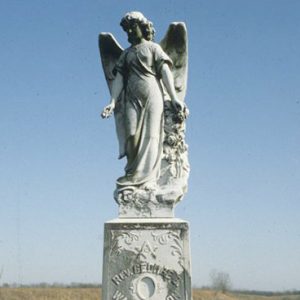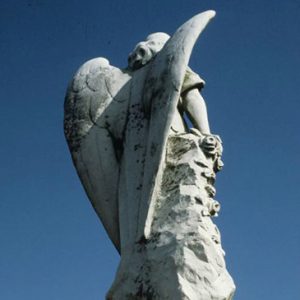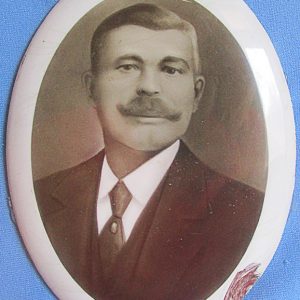calsfoundation@cals.org
George Berry Washington Memorial
The George Berry Washington Memorial, located near Earle (Crittenden County), is the burial place of a man born a slave who rose to become an African-American social leader and one of the largest landowners in the county in the late nineteenth and early twentieth centuries.
George Washington Jr. was born on December 25, 1864, the son of George Washington and Hanna Washington. His parents were both born in Kentucky and were possibly the slaves of James G. Berry, one of Crittenden County’s largest landowners, who moved to Arkansas from Kentucky as early as 1833. In May 1883, Washington—who now went by the name George Berry Washington—married eighteen-year-old Ella Rostelle. They had a daughter, Elizabeth, in 1886 and a second daughter, Irene, in 1891. In 1897, Washington married a second time (no information survives concerning the fate of his first wife); his new bride was twenty-five-year-old Lula Wright of Tennessee.
George Berry Washington was on his way to becoming one of the largest landowners in Crittenden County with the November 1893 purchase of a forty-acre plot for $200. In 1898, he acquired an additional seventy acres, and he also operated a cotton gin. By 1900, he had increased his landholdings to a total of 177 acres worth $1,140. In addition, he owned fifteen cattle, ten horses and mules, ten hogs, a pair of carriages or wagons, and a gold or silver watch. By the turn of the century, Washington and his family lived where the Tyronza River meets Gibson Bayou in an area that became known as the “Main Place” and where the George Berry Washington Memorial is now located. His holdings at the Main Place eventually covered a total of 518 acres.
By 1905, Washington owned 477 acres worth $2,760 and had personal belongings valued at $1,490. By 1911, he owned 924 acres worth $10,690; only eight other Crittenden County farms were larger than his in 1910. Two years of bad weather in 1912–13 forced Washington to place all of his land up for collateral for a $12,000 loan in 1914; however, good crops in 1915 allowed him to increase his total acreage to 1,006 and purchase a pianoforte for his living room. In 1917, Washington’s personal assets totaled $2,710, and he purchased an automobile.
Washington paid off his 1914 loan in 1921 and increased his total holdings to 1,043 acres worth $17,780; he bought a second car in 1925. His land acquisition peaked in 1927 at a total of 1,145 acres valued at $20,900. Washington’s major holdings, in addition to the 518-acre Main Place, were the Chatfield Plantation with 146 acres, the 160-acre Marriman Place, the twenty-acre Harding Place, and another 160 acres at the Dunning Place.
Washington managed part of his vast holdings through the sharecropping system, with twelve chattel mortgages in 1923. It is likely that he also employed from sixty to 100 other farmhands to work other sections of his property. Washington’s plantation featured a one-story frame family home, a commissary store, and a cotton gin, as well as numerous outbuildings, tenant houses, and related structures. None of these buildings survive today.
Washington’s status as a large property owner was mirrored in his social activities. He became a member of the local Prince Hall Freemasonry chapter and bought land in 1902 with two other individuals and Tyronza Lodge No. 197 in Norvell (Crittenden County), the Black residential area north of Earle, possibly as a lodge site. He was also active in several local churches. He served as a preacher at St. Peter’s Baptist Church, located a few miles north of the Main Place, and at the Spring Hill Church three miles east of his home. He also was known to preach to farm hands gathered at his home. Washington deeded five acres in 1919 for the Gibson Bayou Cemetery and Pentecostal Church Association.
Early on the afternoon of August 30, 1928, Washington became ill and collapsed. By 3:00 p.m., he was dead of “acute gastritis.” He was buried on September 2, 1928, on a mound at the Main Place, where the George Berry Washington Memorial stands today.
Elizabeth Washington attempted to continue the farming operations in 1929, but the advent of the Great Depression that year forced Lula Washington and her stepdaughters to borrow nearly $28,000. They defaulted on the loan, and on March 7, 1932, Prudential Insurance Company of America sold the Main Place at auction to satisfy the 1929 note.
The George Berry Washington Memorial consists of a large funerary monument set within a rectangular area surrounded by a low concrete wall. It features two elaborate columns connected by a decorative threshold that forms an entryway to the gravesite, all of which sits atop a low mound. The monument includes a figure of a female angel, approximately five feet tall, standing atop a monolithic marble base, which in turn stands on a pair of marble blocks of graduated sizes, both of which collectively rise to a height of about six feet. The front of the base features a Masonic symbol and is inscribed: “REV. GEORGE B. WASHINGTON DEC. 25, 1864/AUG. 30, 1928/HALLELUJAH! TIS DONE. I BELIEVE IN THE SON/I AM SAVED BY THE BLOOD OF THE CRUCIFIED ONE.” There is a blank oval form in the center of the base that once contained a photoceramic portrait of Washington.
The George Berry Washington Memorial was the inspiration for the painting Angel in the Thorn Patch by noted Arkansas artist Carroll Cloar. The memorial was listed on the National Register of Historic Places on August 11, 1994.
For additional information:
“Angel’s ‘Thorn Patch’ Due Clean-Up by Earle Students.” Crittenden-Cross County Times & Shopping Guide, March 4, 1986, p. 1.
“George Berry Washington Memorial.” National Register of Historic Places nomination form. On file at Arkansas Historic Preservation Program, Little Rock, Arkansas. Online at https://www.arkansasheritage.com/docs/default-source/national-registry/ct0098-pdf.pdf?sfvrsn=43106bb4_0 (accessed November 25, 2025).
Klinger, Timothy C., et al. “Berry Cemetery and George Washington Berry.” Historic Preservation Associates Reports 83-2, January 1983. On file at the Arkansas Archeological Survey, Fayetteville, Arkansas.
LeeDecker, Charles H. Iroquois Research Institute report to U.S. Army Corps of Engineers, Memphis District, February 26, 1980. On file at the Arkansas Archeological Survey, Fayetteville, Arkansas.
Mark K. Christ
Arkansas Historic Preservation Program


 George Berry Washington Memorial
George Berry Washington Memorial  George Berry Washington Memorial
George Berry Washington Memorial  George Berry Washington Portrait
George Berry Washington Portrait 



Comments
No comments on this entry yet.